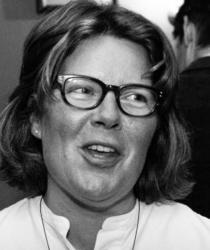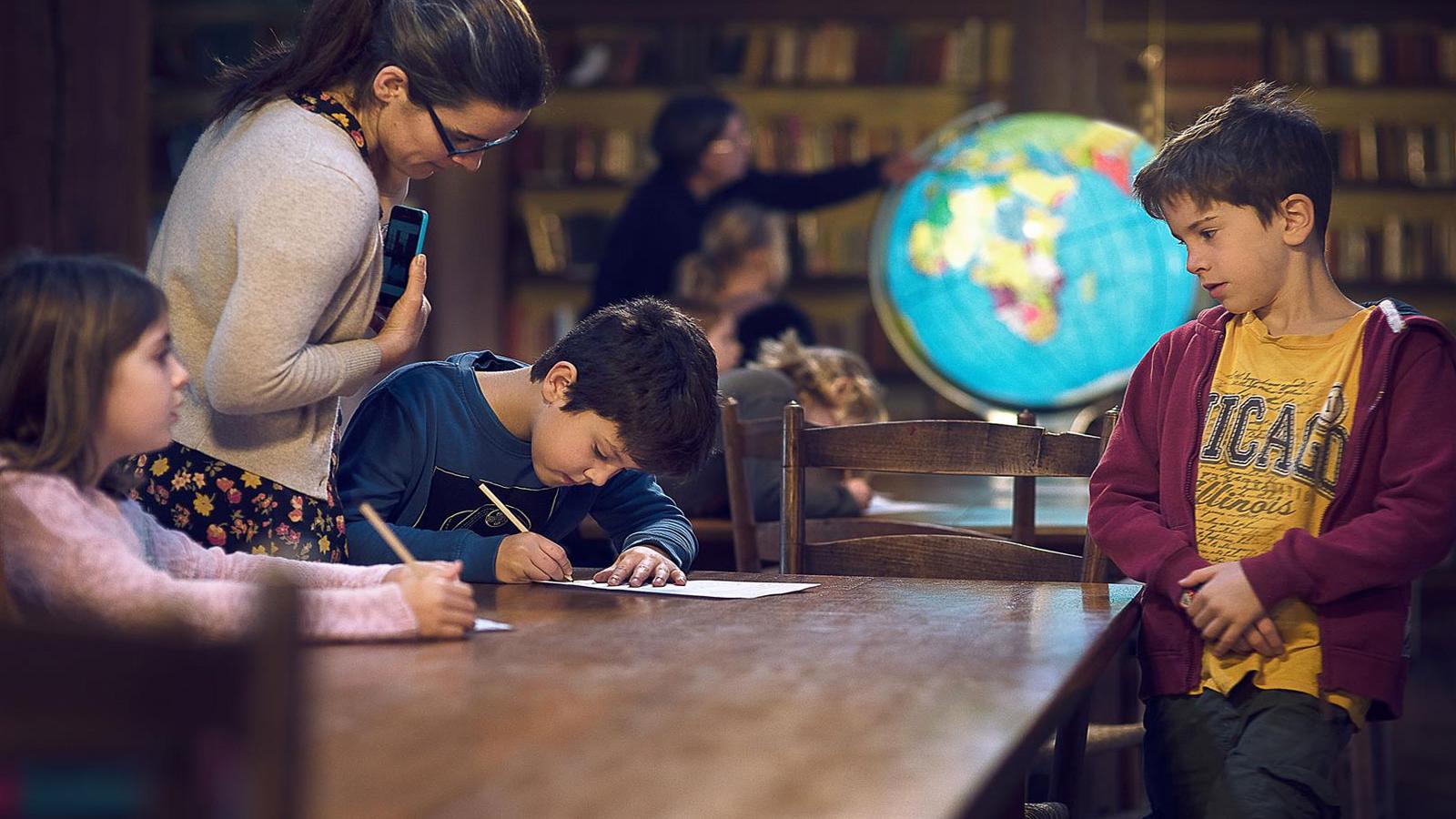
Lucy Holmes’s connections with Bedales originally date back all the way to the age of three, when her family were living in Hampshire and she was sent to Dunannie. “We weren’t just round the corner from school,” Lucy explains, “and Mum used to have to drive miles to get us to Bedales. I would have been five when my father, who was with IBM, was posted up to Scotland and we all went with him. It was there that I was converted from being naturally left-handed to using my right hand for everything – must have been a Scottish thing.”
Not long afterwards, the Holmes family were on the move again, this time to Paris. “I started in the International School there, where I remember meeting the astronaut Neil Armstrong, and then went on to a local French school when I was about eight,” Lucy recalls. “Neither was a great success; I learned next to nothing and eventually was sent back to the UK, where I joined Dunhurst in Group 3. It all seemed somehow familiar to me – a lot of the people I remembered were still there – but for some reason, I was unbelievably homesick when I started boarding. I was also dyslexic and thoroughly unacademic. I didn’t take an entrance exam; instead, I had a lovely interview and a cup of tea with Alastair Langlands, who asked me to spell the word ‘station’. I got that wrong but I was still accepted!”
I was quite sporty, really enjoyed rounders and squash, I played the clarinet and sang in the choir
As she progressed through Dunhurst and into Bedales, Lucy at times showed flashes of her self-confessed anti-authoritarian streak. “Bedales was unbelievably tolerant towards me,” she admits. “I got suspended a few times, mainly for smoking and drinking, and one term I arrived back at Bedales to find that my favourite field had been ploughed up and replaced by netball courts. That was too much for me. I vowed that I would never set foot on the courts – and I never have – and I negotiated with Euan MacAlpine to spend time looking after the chickens instead. Honestly, if it weren’t for Jessie Sheeler, my house mistress, who always stuck up for me, I’m sure that Bedales would have kicked me out!”
In between her acts of rebellion, Lucy was enjoying a full Bedalian life. “I was quite sporty, really enjoyed rounders and squash, I played the clarinet and sang in the choir but I was still finding the academic side difficult,” she reflects. “I wasn’t bad at French and I was reasonably artistic but it was tough going for me. Fortunately, the whole Bedales environment helped me in that respect. Academic success was never overtly emphasised as the be-all and end-all of our education; on the contrary, whatever your interests were, no matter what you achieved, you were made to feel that you were OK.”
As she began to ponder her future beyond Bedales, Lucy’s early inclination was to become a vet. “Harriet Heslop was my form teacher one year and it was she who gently persuaded me that I wasn’t likely to pass the science exams that I would need!” Lucy remembers. “My turning point came after watching a film called The Power of Ten in Civics. I was artistic but I didn’t want to be an artist – a blank piece of paper seemed terrifying to me – but I could now understand that communicating ideas on paper, graphic design, could be something that worked for me. Having worked that out, I then set about discovering where the best place to study design might be.”
That place turned out to be the Rhode Island School of Design in the USA. “We went out to have a look at the place in the summer holiday after my 6.1 year,” Lucy explains. “The family was already up to speed on the American college system because my brother Simon was out there on a golf scholarship and Rhode Island wanted to see how well I could draw. The upshot was that I got an unconditional place offer for the year after I finished at Bedales. I didn’t need to pass my A-Levels, but I was determined to do that in any case; I persevered with my art and also did French and English and I was especially lucky with my English teachers. There was such enormous passion for their subject with Tim, John and Graham and I was never made to feel that I was somehow any less intelligent than everyone else.”
Lucy arrived at Rhode Island ready for and enthusiastic about her next adventure. “Bedales had already helped me to become an independent person but it hadn’t quite prepared me for the language barrier I found in the States,” she observes. “I had naïvely assumed that we all spoke the same language but for some reason, people seemed to have a hard time understanding what I was saying! There was no doubt, however, that I was surrounded by a lot of super-talented artists and no doubt either about how hard we all worked. It was a four-year course, there were classes all day, homework from every class and if you didn’t keep your grades up, you couldn’t stay. I was incredibly fortunate to be funded by my folks while most of my peers took out student loans and also so lucky to be instructed by such world-class teachers.”
My turning point came after watching a film called The Power of Ten in Civics. I was artistic but I didn’t want to be an artist – a blank piece of paper seemed terrifying to me – but I could now understand that communicating ideas on paper, graphic design, could be something that worked for me
One of these teachers was Doug Scott, who returned to Rhode Island at the beginning of one semester with the new design of The Guardian newspaper to show his students. “It had been created by David Hillman, who was a partner at Pentagram in London,” says Lucy. “Almost immediately I decided that I wanted to work for David, I wrote to him and eventually he offered me a job. Pentagram was the place where I really earned my graphic design spurs. It was then and still is an independent operation run almost as a family, which totally suited me. We hardly got paid anything but I had learned at Bedales that it’s my passion for what I do that counts, rather than money or status. I had to waitress on the weekends but all the time, I was getting these wonderful projects to work on for clients like the Tate Gallery and The Guardian, as well as designing book jackets and that sort of thing. If you’re prepared to put in the hours, you can learn and improve so much and that’s what I did at Pentagram.”
Most of Lucy’s contemporaries at Pentagram would go on to start their own design businesses and one day, prompted by her participation in the London Marathon, Lucy decided to join their number. “A friend of mine and I decided to run the marathon in aid of a cancer charity and we both trained really hard for it,” she recalls. “I’m in no way a natural runner but I managed to finish the course in 4 hours 24 minutes and about halfway round, I said to myself that if I could manage this, I could surely manage my own business.”
Beginning in 1996, Lucy was given a helping hand by Pentagram, who gave her the company’s Tate Gallery work for her new business. “That grew into doing the graphics for the opening of Tate Modern on behalf of Wolff Olins, the brand consultants,” she says. “I worked on that for two years, assessing how the whole building space could potentially function, and started to collaborate a lot with Alex Wood, who came from a sign-making background and helped me a lot on the strategic side.”
The building blocks for a dynamic new enterprise were now in place and Holmes Wood Design was duly opened for business in the year 2000. Within a year, the company had landed the contract to handle the design for the V&A Museum in London. “Because of its size, the V&A project is still one of those of which I’m most proud,” Lucy reflects. “The way the company grew was amazing and it was partly because at Bedales I’d learned to talk to anyone and wasn’t worried about having meetings with people like Nicholas Serota while I was still in my 20s. I think the growth also happened because no-one else was looking at design in the way that we were at Holmes Wood. Whether we were designing for an airport, a gallery or an open space, the idea was always to create almost invisible design that put people at its heart and allowed them to have a better time so that they would want to return.”
The way the company grew was amazing and it was partly because at Bedales I’d learned to talk to anyone
Two years ago, Lucy and Alex decided to sell Holmes Wood, which by then had added clients of the calibre of The National Gallery, Buckingham Palace, Windsor Castle, Virgin Atlantic, the American Museum of Natural History, the Science Museum and Battersea Power Station to its portfolio. The industry had changed beyond recognition since Lucy had taken her first steps in it. “In some ways it certainly had,” she agrees. “Computers have made the mechanics of the process a lot easier and I’m constantly surprised by how few of the younger graphic artists have a real sense of the history of their trade. On the other hand, I’ve always tried not to set myself against new technology – having a young team working with me has helped there – and the one thing that has always remained true is the need for fresh ideas. Without an idea, you’re history.”
Lucy remained at Holmes Wood after its sale, moved studios and became a company employee once again until she took the decision in September of 2018 to step away once and for all. “What more could I do there?” she asks. “It was time for me to move on. For the last few months I’ve been in a position to take time off, discuss future options and projects with loads of interesting people and think about my next move, which will happen in the New Year. I truly believe that the best is yet to come.”
The girl who struggled against dyslexia at school has achieved extraordinary things and Lucy is keen to place at least part of the credit for them at the doorstep of her old school. “We were always encouraged to have our own opinions,” she says. “At a time when our hormones were all over the place and we were naturally pushing boundaries, Bedales wanted to know what we felt or thought and to push us into becoming people who questioned things. It’s a huge part of the Bedales character.”
“You make your own luck to some extent but all of us at Bedales know how lucky we were in the way that we were taught there,” Lucy concludes. “Many Bedalians have gone on to do wonderful artistic things – I’ve worked with people like Miraphora Mina and Sebastian Bergne, for example, the Glynn Smith girls as well, all of whom are so talented. Whenever we get together there is always this unspoken recognition that we come from somewhere special. It’s such a strong connection and with most of my best friends being Bedales people, that connection will always be there.”
